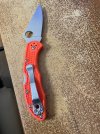-
The BladeForums.com 2024 Traditional Knife is ready to order! See this thread for details: https://www.bladeforums.com/threads/bladeforums-2024-traditional-knife.2003187/
Price is$300$250 ea (shipped within CONUS). If you live outside the US, I will contact you after your order for extra shipping charges.
Order here: https://www.bladeforums.com/help/2024-traditional/ - Order as many as you like, we have plenty.
You are using an out of date browser. It may not display this or other websites correctly.
You should upgrade or use an alternative browser.
You should upgrade or use an alternative browser.
The Spydiest of Spydercos Has Arrived: Delica in SPY27
- Thread starter Humint
- Start date
jmh33
Gold Member
- Joined
- Mar 16, 2003
- Messages
- 10,932
Black clips are a mistake!!I just got my Delica a few minutes ago but first impression is great. Super sharp , and love the color. I was also happy to see they went the non-coated clip which really looks good to me.
Flows better with the stainless!!
John
- Joined
- Jun 6, 2014
- Messages
- 621
Especially when it's the only black part on the knife, like when the scales are a different color than black.Black clips are a mistake!!
Flows better with the stainless!!
John
jmh33
Gold Member
- Joined
- Mar 16, 2003
- Messages
- 10,932
There was no testing in support of that article. The author states at the end: “Unfortunately, I am probably unlikely to get flatstock for experiments due to the steel being exclusive to Spyderco.“ That makes it all basically a guess.For me (and limited use on a Spyderco Native 5 lightweight SPY27) SPY27 is above VG10 in all around performance. Below is a composition comparison between both steels.
Composition & Properties Comparison:
Property VG-10 SPY27 Maker Takefu (Japan) Spyderco + Crucible (USA) Carbon 1.0% 1.25% Chromium 15% 14% Vanadium 0.2% 1% Cobalt 1.5% 1.5% Molybdenum 1% 2% Niobium None 1% Edge Retention Good Better Toughness Decent Slightly better Corrosion Resistance Excellent Excellent Sharpening Ease Easy Moderate (still very manageable)
SPY27 not only has a higher alloy content than VG-10, but it's also a powdered metallurgy steel, whereas VG-10 is an ingot steel. For me, SPY27 feels closer in performance to S35VN than VG-10—but it's noticeably easier to maintain.
When comparing steels, I usually focus on corrosion resistance, edge retention, and toughness, and I benchmark against the steels I’ve used the most: VG-10, S30V, and S35VN.
Knife Steel Nerds has a great analysis on SPY27 here:
SPY27 Analysis – Knife Steel Nerds
From that article:
- Corrosion resistance:
SPY27 – 7.9
VG-10 – 8.0
S30V & S35VN – 7.8- Edge retention (CATRA at 61 HRC):
SPY27 – 128
VG-10 – 103
S30V – 144
S35VN – 134- Toughness:
SPY27 seems to be at least as tough as S35VN, and in my experience, it performs better than VG-10 in that regard.
While I still think VG-10 is a solid steel (and I wouldn't hesitate to carry it), if I had the choice, I’d go with SPY27 each and every time.
To me, it’s just so cool that Spyderco’s most iconic model, the Delica, now comes in a steel developed by Spyderco themselves. It really feels like the perfect marriage of design, steel, and brand philosophy.
The Delica is just a smaller Endura which is the iconic Spyderco knife.
- Joined
- Feb 29, 2012
- Messages
- 796
There was no testing in support of that article. The author states at the end: “Unfortunately, I am probably unlikely to get flatstock for experiments due to the steel being exclusive to Spyderco.“ That makes it all basically a guess.
Steel was later provided and usual tests completed, which generally verified predictions of similar wear resistance, toughness, and stainlessness to S30V/S35VN.
Testing article here: https://knifesteelnerds.com/2020/03...ents-toughness-corrosion-resistance-and-more/
- Joined
- Mar 1, 2010
- Messages
- 268
Will someone please get the word to Spyderco! Black clips look like crap on most of their knives and IMO are just a cost cutting measure that greatly cheapens the look of otherwise beautiful knives. They also get scratched up and the paint starts coming off very quickly making it look even worse. The only time a clip should be black is when the blade is black. Going back a few years I remember you could order the polished clips and replace black clips on Delicas, Enduras, etc. but it appears they are no longer available. If they were I would have a dozen on order to replace all my black painted clips. Rant off.Black clips are a mistake!!
Flows better with the stainless!!
John

